| Tweet | Follow @co2science |
Paper Reviewed
Fernández-Martínez, M., Sardans, J., Chevallier, F., Ciais, P., Obersteiner, M., Vicca, S., Canadell, J.G., Bastos, A., Friedlingstein, P., Sitch, S., Piao, S.L., Janssens, I.A. and Peñuelas, J. 2019. Global trends in carbon sinks and their relationships with CO2 and temperature. Nature Climate Change 9: 73-79.
Although experimental studies have long confirmed that elevated atmospheric CO2 concentrations stimulate plant growth via the aerial fertilization effect, the extent to which it increases net ecosystem production (NEP) across the globe is still debated. And, thus, this challenge was the objective of a recent study by Fernández-Martínez et al. (2019) in the journal Nature Climate Change.
The technique applied by the team of thirteen researchers was to utilize multidecadal inversion models and an ensemble of dynamic global vegetation models (DVGMs) to estimate global NEP over the period 1995 to 2014. The inversion models provided gridded estimates for the net fluxes of land-atmosphere CO2 exchange, i.e. NEP, which were then examined in conjunction with atmospheric CO2, climate, land-use, and atmospheric nitrogen and sulfur deposition data to determine the relative impacts of these several factors on global NEP trends.
And what did this study reveal?
As indicated by Fernández-Martínez et al., global NEP increased by 117 to 178 Tg C yr-1 depending on the inversion model used, which increase was strongly influenced by NEP gains in Siberia, Asia, Oceania and South America (see Figure 1). Latitudinally, the majority of the NEP increases occurred in the tropics, where despite containing only around 22% of the global land area (excluding Antarctica), this region accounted for around half of the total NEP increase.
With respect to the cause responsible for the rising NEP trend, the authors report that "increasing CO2 was the main factor ... with a consistent positive temporal contribution for almost all the latitudinal bands considered." And in this regard they note that, "proportionally, increasing CO2 accounted for more than 90% of the trends in NEP" (see Figure 1, right side), whereas the proportional contribution from temperature amounted to less than 10%.
In further calculating the global sensitivity of NEP to increasing CO2, the authors determined that a 1 ppm rise in atmospheric CO2 was able to sequester between 6 and 8 Tg of carbon. Consequently, given these several findings, Fernández-Martínez et al. conclude that their study "highlights the dominant role of rising atmospheric CO2 concentrations triggering an increase in land carbon sinks over the entire planet from 1995 to 2014." And it adds further proof to the growing narrative that the whole of the terrestrial biosphere is benefitting from the CO2 fertilization effect.

Figure 1. Global trends in NEP and their contributing factors as determined by the MACC-II (Panel a) and Jena CarboScope (Panel b) inversions models. Global temporal contributions of CO2, climate and land-use change to the trends in NEP (annual change) are shown on the right side of each panel. The difference between the modelled temporal contributions and the trends (shaded) was treated as an unknown contribution to the temporal variation in NEP. Statistically significant (P < 0.01) temporal variations of the predictors are shown in square brackets (CO2, ppm yr-1; temperature, °C yr-1; precipitation, mm yr-2; SPEI, s.d.; forests, crops and urban areas, percentage of land-use cover per pixel) . Error bars indicate 95% confidence intervals. Significance levels: *P < 0.01, **P < 0.001. Source: Fernández-Martínez et al. (2019).




